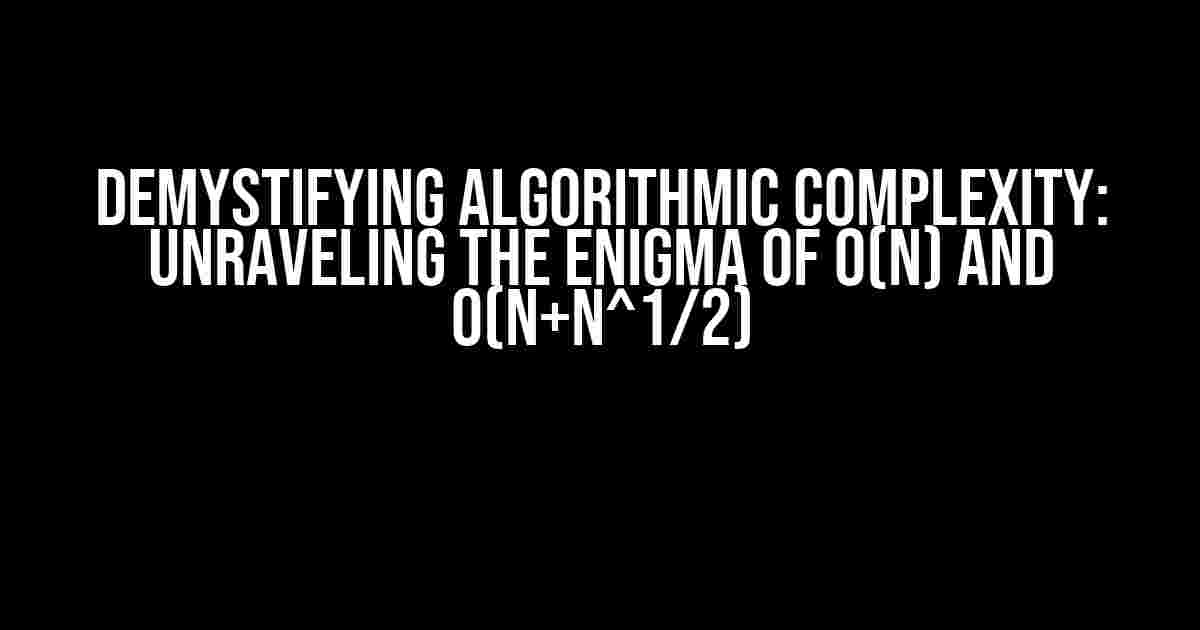When venturing into the realm of algorithm design, one encounters a plethora of confusing notations and symbols. Two such notations, O(n) and O(n+n^1/2), often leave developers scratching their heads. In this article, we’ll delve into the mysteries of algorithmic complexity, exploring the differences between these two notations and providing clarity on their applications.
What is Algorithmic Complexity?
Algorithmic complexity refers to the measure of how efficient an algorithm is in terms of the amount of time or space it requires as the input size grows. It’s essential to understand that complexity is not about the absolute time or space taken, but rather how they scale with the input size.
Big O Notation
The Big O notation is a mathematical representation used to describe the upper bound of an algorithm’s complexity. It’s an asymptotic notation, meaning it focuses on the behavior of the algorithm as the input size approaches infinity. In simpler terms, Big O notation gives an estimate of how an algorithm’s performance will degrade as the input size increases.
O(n) and O(n+n^1/2) are examples of Big O notations.O(n) – The Linear Complexity
O(n) represents a linear complexity, which means the algorithm’s running time or space requirements grow linearly with the input size. In other words, if the input size doubles, the running time or space required will also double.
Example algorithms with O(n) complexity include:
- Linear search in an array
- Counting the number of elements in an array
- Finding the maximum or minimum value in an array
for (int i = 0; i < n; i++) {
// do something
}The above code snippet demonstrates a simple loop that iterates over an array of size n. The running time of this loop is directly proportional to the size of the input array, making it an O(n) algorithm.
O(n+n^1/2) - The Curious Case of Non-Linearity
O(n+n^1/2) represents a complexity that is a combination of linear and non-linear components. The 'n' term represents the linear component, while the 'n^1/2' term represents the non-linear component.
In this complexity, the running time or space requirements grow at a rate that's faster than linear but slower than quadratic. To understand this better, let's break it down:
- The 'n' term dominates when the input size is small, making the algorithm's performance similar to O(n).
- As the input size increases, the 'n^1/2' term starts to dominate, causing the algorithm's performance to degrade faster than O(n) but slower than O(n^2).
for (int i = 0; i < n; i++) {
for (int j = 0; j < sqrt(n); j++) {
// do something
}
}The above code snippet demonstrates a nested loop where the outer loop iterates 'n' times, and the inner loop iterates approximately sqrt(n) times. The total number of iterations is roughly n + n^1/2, making it an O(n+n^1/2) algorithm.
Key Differences Between O(n) and O(n+n^1/2)
The main differences between O(n) and O(n+n^1/2) lie in their scaling behavior:
| Complexity | Scaling Behavior | Example Algorithm |
|---|---|---|
| O(n) | Linear | Linear search in an array |
| O(n+n^1/2) | Non-linear (faster than linear, slower than quadratic) | Nested loop with sqrt(n) iterations |
When to Use Each Complexity
Choosing the right complexity for an algorithm depends on the problem's requirements and constraints:
- Use O(n) when:
- The problem requires a simple, efficient solution.
- The input size is relatively small.
- Use O(n+n^1/2) when:
- The problem requires a balance between efficiency and accuracy.
- The input size is moderately large, and a non-linear approach is necessary.
Conclusion
In the realm of algorithm design, understanding the differences between O(n) and O(n+n^1/2) is crucial for crafting efficient and scalable solutions. By grasping the nuances of these complexities, developers can make informed decisions about which algorithm to use, ultimately leading to faster and more reliable software.
Remember, when faced with the enigma of algorithmic complexity, it's essential to consider the problem's requirements, the input size, and the desired trade-offs between efficiency and accuracy. With practice and experience, you'll become a master of navigating the intricacies of Big O notation and crafting optimal algorithms that leave a lasting impact.
Frequently Asked Questions
Q: What is the main difference between O(n) and O(n+n^1/2)?
A: O(n) represents a linear complexity, while O(n+n^1/2) represents a non-linear complexity that combines linear and non-linear components.
Q: When should I use O(n) instead of O(n+n^1/2)?
A: Use O(n) when the problem requires a simple, efficient solution, and the input size is relatively small.
Q: How do I determine the complexity of an algorithm?
A: Analyze the algorithm's loop structure, recursive calls, and data access patterns to determine its complexity. Use the Big O notation to describe the upper bound of the algorithm's complexity.
Frequently Asked Question
Ever wondered about the nuances of Big O notation in algorithms? Let's dive into the differences between O(n) and O(n+n^1/2)!
What's the main difference between O(n) and O(n+n^1/2) in algorithm complexity?
The primary distinction lies in the growth rate of the functions. O(n) represents a linear growth rate, where the time complexity increases directly with the size of the input (n). On the other hand, O(n+n^1/2) represents a more complex growth rate, which includes a linear component (n) and an additional term that grows at a slower rate (n^1/2). This mixed term affects the algorithm's performance for large inputs.
How do I simplify O(n+n^1/2) to a more familiar Big O notation?
You can simplify O(n+n^1/2) to O(n) because the n term dominates the n^1/2 term as n approaches infinity. In Big O notation, we only care about the highest-order term, which in this case is the linear term (n).
What kind of algorithms typically have a time complexity of O(n+n^1/2)?
Algorithms that involve a combination of linear operations and square root operations might exhibit a time complexity of O(n+n^1/2). Examples include certain types of sorting algorithms, graph algorithms, and numerical algorithms that involve iterative refinements.
Is O(n+n^1/2) considered an efficient algorithm?
While O(n+n^1/2) is not as efficient as O(log n) or O(1), it's still considered relatively efficient compared to exponential or factorial time complexities. However, the actual performance depends on the specific problem and the input size.
Can I always ignore the lower-order terms in Big O notation?
Not always! While it's common to drop lower-order terms in Big O notation, there are cases where they matter. For instance, when dealing with extremely large inputs or when the lower-order term has a significant coefficient, it's essential to consider the entire expression to accurately analyze the algorithm's performance.


